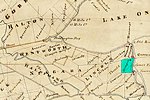Tweed Farms
Buildings and structures in Niagara-on-the-LakeCannabis companies of CanadaCannabis greenhousesCannabis in OntarioCannabis stubs ... and 1 more
Greenhouses in Canada
Tweed Farms in Niagara-on-the-Lake, Ontario was the world's largest legal cannabis greenhouse in 2014. At that time, it had 350,000 square feet (33,000 m2) of indoor space. It is owned by Canopy Growth Corporation, a publicly traded Canadian company. In 2017 the company received a license to expand to c. 1,000,000 square feet (93,000 m2) of space, to be ready for production by April 2018.In November 2021, Canopy Growth Corporation shut down Tweed Farms as the company struggled with profitability. As a result of the closure, 30 staff were laid off and 60 staff would be relocated to other indoor facilities in Kincardine, Ontario and Smiths Falls, Ontario.
Excerpt from the Wikipedia article Tweed Farms (License: CC BY-SA 3.0, Authors).Tweed Farms
Concession 5,
Geographical coordinates (GPS) Address Nearby Places Show on map
Geographical coordinates (GPS)
| Latitude | Longitude |
|---|---|
| N 43.1683 ° | E -79.1195 ° |
Address
Concession 5
Concession 5
L0S 1P0
Ontario, Canada
Open on Google Maps






